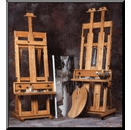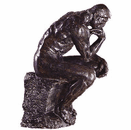True Artists or Just Crazy People?
True Artists or Just Crazy People?
As we look through history, it doesn’t take a magnifying glass to determine that many of the true artists have had a shred of lunacy running through their veins. Which brings up a valid question, do you have to be crazy in order to be a true artist?
For argument sake, we’ve made a list of some of the greatest artists from history and collected some facts surrounding their sanity. In the end, we’ll let you decide if you think these people are true artists … or just crazy people.
1. Vincent Van Gogh
Born in the Netherlands in 1853, Vincent Van Gogh was an extremely prolific painter that is responsible for some of the most famous paintings of all time including Starry Night and his many self-portraits. However, as a known victim of depression, Van Gogh spent time in an asylum, famously cut off his own left ear and ultimately, at the age of 37, shot himself in the chest with a revolver.
"Sometimes moods of indescribable anguish, sometimes moments when the veil of time and fatality of circumstances seemed to be torn apart for an instant." – Vincent Van Gogh

IMG SOURCE: expo-vangogh. com/painting/vg305.jpg
2. Jackson Pollack
Born in Wyoming in 1912, Jackson Pollack is best known for his abstract expressionism that may look like spattered chaos at first glance, however, with some understanding, it becomes a detailed map of his brain. He did enjoy some notoriety during his lifetime but because he battled terribly with depression, he was a known alcoholic and eventually died in an alcohol related car accident.
“Every good painter paints what he is.” – Jackson Pollack

IMG SOURCE: bp.blogspot. com/_wvppyGB6cjc/TTERsch2G5I/AAAAAAAAAEE/K-xn_-g6OW8/s1600/action-painting.jpg
3. Mark Rothko
Russian born but eventually an American immigrant, Mark Rothko was another abstract painter, however, his work was much more basic and controlled than that of Jackson Pollack. Using simple blocks of complementary colors, Rothko experienced great success in his career but internally struggled with deep depression. In fact, his world was so dark that at age 66, he was found dead on his kitchen floor after having slit his own wrists.
“The people who weep before my pictures are having the same religious experience I had when I painted them. And if you, as you say, are moved only by their color relationship, then you miss the point.” – Mark Rothko

IMG SOURCE: .talltalestruetales. com/wp-content/uploads/2008/08/mark_rothko.jpg
4. Jean-Michel Basquiat
Beginning his artistic career as a graffiti artist known as SAMO in New York City, Jean-Michel Basquiat eventually evolved his craft into what is being classified as neo-expressionism. Although his art was well received, Basquiat suffered from paranoia and struggled with a drug addiction that eventually took his life. At the age of 27 he died from a heroine overdose.
“I had some money, I made the best paintings ever. I was completely reclusive, worked a lot, took a lot of drugs. I was awful to people.” – Jean-Michel Basquiat

IMG SOURCE: fopsobserver. com/wp-content/uploads/2011/03/Jean_michel_basquiat_2.jpg
5. Salvador Dali
Originally a draftsman, Salvador Dali was a Spanish painter that is best known for his work, The Persistence of Memory – a dreamlike and psychedelic painting which features melting pocket watches. While Dali wasn’t necessarily insane or depressed, he typically engaged in ostentatious public behavior that was highly eccentric and alarming to his critics, including a funny TV commercial for French chocolates.
“I don't do drugs. I am drugs.” – Salvador Dali

IMG SOURCE: munrovian.files.wordpress. com/2010/05/salvador-dali.jpg
6. Richard Dadd
Born in 1817, Richard Dadd was a British painter that was most famous for his depictions of supernatural beings – his opus was The Fairy Feller's Master-Stroke. Although he was considered an extreme talent from an early age, at the age of 20, he became delusional and believed that he was possessed by the Egyptian god Osiris. Needless to say, the remainder of his many paintings were created inside the walls of a variety of psychiatric hospitals.
“I was roused to a consideration of subjects which I had previously never dreamed of … connected with self; and I had such ideas that, had I spoken of them openly, I must, if answered in the world’s fashion, have been told I was unreasonable.” – Richard Dadd

IMG SOURCE: echostains.files.wordpress. com/2011/08/44883514_37f4255a-69fb-45b0-8557-96253496f674.jpg?w=300&h=193

IMG SOURCE: mydailyartdisplay.files.wordpress. com/2011/06/the-fairy-fellers-master-stroke-by-richard-dadd.jpg?w=784&h=1024
7. Caravaggio
Born in 1571, Michelangelo Merisi da Caravaggio was an Italian artist that never handled his success with much grace. Despite having many patrons and being considered the "most famous painter in Rome" from 1600–1606, Caravaggio was jailed many times, had a death warrant issued for him and was known to pick a fight or two. In fact, at one point in his amateur fighting career, he killed a young man with a knife in a brawl and was forced to flee Rome as a result.
“Welcome to Fight Club. The first rule of Fight Club is: you do not talk about Fight Club. The second rule of Fight Club is: you DO NOT talk about Fight Club!” – Caravaggio (Just kidding, no quote was available)

IMG SOURCE: i.telegraph. co.uk/multimedia/archive/01543/Caravaggio_1543855c.jpg
8. Michelangelo
In this instance, the line of being a true artist and just plain crazy is tiptoed like no other. Although there are no signs of blatant insanity in the case of Michelangelo, many speculate that, in addition to depression, Michelangelo suffered from Autism. In the end, he was hyper-obsessive about his work and spent four grueling years on the Sistine Chapel without a break. Additionally, history also says that he ignored any kind of personal hygiene for the sake of his projects.
“I am a poor man and of little worth, who is laboring in that art that G-d has given me in order to extend my life as long as possible.” – Michelangelo

IMG SOURCE: static.howstuffworks. com/gif/michelangelo-biography-2.jpg
9. Paul Gauguin
Born in France in 1848, Paul Gauguin was a colleague of Vincent Van Gogh and actually shared some of the same interests such as, depression and suicidal tendencies (Gauguin was the last to see Van Gogh before he cut off his own ear). Although Gauguin was one of the most influential artists of his time, he attempted suicide at one point, suffered a severe mid-life crisis, battled alcoholism and ultimately fled to Tahiti in the last few years of his life to paint in peace.
“We never really know what stupidity is until we have experimented on ourselves.” – Paul Gauguin

IMG SOURCE: onthisdeity. com/wp-content/uploads/2011/05/paulgauguin.jpg
10. Emily Dickinson
Although she is not a visual artist, it’s worth mentioning Emily Dickinson, her poetic art and her bouts with social anxiety. Born in Amherst, Massachusetts in 1830, Dickinson was viewed mostly as an odd-bird recluse that spent the majority of her adult life in her room. In her lifetime only about 10 poems were ever published, however, after her death at 55, it was discovered that her anti-social tendencies were the inspiration for her secret catalog of 1,800 poems that were later found by her sister.
”Pardon my sanity in a world insane” – Emily Dickinson

IMG SOURCE: literaryhistory. com/19thC/Public_Domain_Photos/Dickinson.jpg
As we look through history, it doesn’t take a magnifying glass to determine that many of the true artists have had a shred of lunacy running through their veins. Which brings up a valid question, do you have to be crazy in order to be a true artist?
For argument sake, we’ve made a list of some of the greatest artists from history and collected some facts surrounding their sanity. In the end, we’ll let you decide if you think these people are true artists … or just crazy people.
1. Vincent Van Gogh
Born in the Netherlands in 1853, Vincent Van Gogh was an extremely prolific painter that is responsible for some of the most famous paintings of all time including Starry Night and his many self-portraits. However, as a known victim of depression, Van Gogh spent time in an asylum, famously cut off his own left ear and ultimately, at the age of 37, shot himself in the chest with a revolver.
"Sometimes moods of indescribable anguish, sometimes moments when the veil of time and fatality of circumstances seemed to be torn apart for an instant." – Vincent Van Gogh

IMG SOURCE: expo-vangogh. com/painting/vg305.jpg
2. Jackson Pollack
Born in Wyoming in 1912, Jackson Pollack is best known for his abstract expressionism that may look like spattered chaos at first glance, however, with some understanding, it becomes a detailed map of his brain. He did enjoy some notoriety during his lifetime but because he battled terribly with depression, he was a known alcoholic and eventually died in an alcohol related car accident.
“Every good painter paints what he is.” – Jackson Pollack

IMG SOURCE: bp.blogspot. com/_wvppyGB6cjc/TTERsch2G5I/AAAAAAAAAEE/K-xn_-g6OW8/s1600/action-painting.jpg
3. Mark Rothko
Russian born but eventually an American immigrant, Mark Rothko was another abstract painter, however, his work was much more basic and controlled than that of Jackson Pollack. Using simple blocks of complementary colors, Rothko experienced great success in his career but internally struggled with deep depression. In fact, his world was so dark that at age 66, he was found dead on his kitchen floor after having slit his own wrists.
“The people who weep before my pictures are having the same religious experience I had when I painted them. And if you, as you say, are moved only by their color relationship, then you miss the point.” – Mark Rothko

IMG SOURCE: .talltalestruetales. com/wp-content/uploads/2008/08/mark_rothko.jpg
4. Jean-Michel Basquiat
Beginning his artistic career as a graffiti artist known as SAMO in New York City, Jean-Michel Basquiat eventually evolved his craft into what is being classified as neo-expressionism. Although his art was well received, Basquiat suffered from paranoia and struggled with a drug addiction that eventually took his life. At the age of 27 he died from a heroine overdose.
“I had some money, I made the best paintings ever. I was completely reclusive, worked a lot, took a lot of drugs. I was awful to people.” – Jean-Michel Basquiat

IMG SOURCE: fopsobserver. com/wp-content/uploads/2011/03/Jean_michel_basquiat_2.jpg
5. Salvador Dali
Originally a draftsman, Salvador Dali was a Spanish painter that is best known for his work, The Persistence of Memory – a dreamlike and psychedelic painting which features melting pocket watches. While Dali wasn’t necessarily insane or depressed, he typically engaged in ostentatious public behavior that was highly eccentric and alarming to his critics, including a funny TV commercial for French chocolates.
“I don't do drugs. I am drugs.” – Salvador Dali

IMG SOURCE: munrovian.files.wordpress. com/2010/05/salvador-dali.jpg
6. Richard Dadd
Born in 1817, Richard Dadd was a British painter that was most famous for his depictions of supernatural beings – his opus was The Fairy Feller's Master-Stroke. Although he was considered an extreme talent from an early age, at the age of 20, he became delusional and believed that he was possessed by the Egyptian god Osiris. Needless to say, the remainder of his many paintings were created inside the walls of a variety of psychiatric hospitals.
“I was roused to a consideration of subjects which I had previously never dreamed of … connected with self; and I had such ideas that, had I spoken of them openly, I must, if answered in the world’s fashion, have been told I was unreasonable.” – Richard Dadd

IMG SOURCE: echostains.files.wordpress. com/2011/08/44883514_37f4255a-69fb-45b0-8557-96253496f674.jpg?w=300&h=193

IMG SOURCE: mydailyartdisplay.files.wordpress. com/2011/06/the-fairy-fellers-master-stroke-by-richard-dadd.jpg?w=784&h=1024
7. Caravaggio
Born in 1571, Michelangelo Merisi da Caravaggio was an Italian artist that never handled his success with much grace. Despite having many patrons and being considered the "most famous painter in Rome" from 1600–1606, Caravaggio was jailed many times, had a death warrant issued for him and was known to pick a fight or two. In fact, at one point in his amateur fighting career, he killed a young man with a knife in a brawl and was forced to flee Rome as a result.
“Welcome to Fight Club. The first rule of Fight Club is: you do not talk about Fight Club. The second rule of Fight Club is: you DO NOT talk about Fight Club!” – Caravaggio (Just kidding, no quote was available)

IMG SOURCE: i.telegraph. co.uk/multimedia/archive/01543/Caravaggio_1543855c.jpg
8. Michelangelo
In this instance, the line of being a true artist and just plain crazy is tiptoed like no other. Although there are no signs of blatant insanity in the case of Michelangelo, many speculate that, in addition to depression, Michelangelo suffered from Autism. In the end, he was hyper-obsessive about his work and spent four grueling years on the Sistine Chapel without a break. Additionally, history also says that he ignored any kind of personal hygiene for the sake of his projects.
“I am a poor man and of little worth, who is laboring in that art that G-d has given me in order to extend my life as long as possible.” – Michelangelo

IMG SOURCE: static.howstuffworks. com/gif/michelangelo-biography-2.jpg
9. Paul Gauguin
Born in France in 1848, Paul Gauguin was a colleague of Vincent Van Gogh and actually shared some of the same interests such as, depression and suicidal tendencies (Gauguin was the last to see Van Gogh before he cut off his own ear). Although Gauguin was one of the most influential artists of his time, he attempted suicide at one point, suffered a severe mid-life crisis, battled alcoholism and ultimately fled to Tahiti in the last few years of his life to paint in peace.
“We never really know what stupidity is until we have experimented on ourselves.” – Paul Gauguin

IMG SOURCE: onthisdeity. com/wp-content/uploads/2011/05/paulgauguin.jpg
10. Emily Dickinson
Although she is not a visual artist, it’s worth mentioning Emily Dickinson, her poetic art and her bouts with social anxiety. Born in Amherst, Massachusetts in 1830, Dickinson was viewed mostly as an odd-bird recluse that spent the majority of her adult life in her room. In her lifetime only about 10 poems were ever published, however, after her death at 55, it was discovered that her anti-social tendencies were the inspiration for her secret catalog of 1,800 poems that were later found by her sister.
”Pardon my sanity in a world insane” – Emily Dickinson

IMG SOURCE: literaryhistory. com/19thC/Public_Domain_Photos/Dickinson.jpg
Copyright © 2002-2025 Madison Art Shop™ LLC. All Rights Reserved.
















